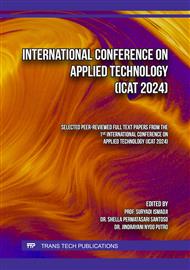[1]
A. Nikiforov, A. Kinzhibekova, E. Prikhodko, A. Karmanov, and S. Nurkina, Analysis of the Characteristics of Bio-Coal Briquettes from Agricultural and Coal Industry Waste, Energies (Basel), 16 (2023).
DOI: 10.3390/en16083527
Google Scholar
[2]
W. Gwenzi, R. S. Ncube, and T. Rukuni, Development, properties and potential applications of high-energy fuel briquettes incorporating coal dust, biowastes and post-consumer plastics, SN Appl Sci, 2 (2020).
DOI: 10.1007/s42452-020-2799-8
Google Scholar
[3]
S.N.F.S. Adam, J.H. M. Aiman, F. Zainuddin, and Y. Hamdan, Processing and Characterisation of Charcoal Briquettes Made from Waste Rice Straw as A Renewable Energy Alternative, JPCS (2021).
DOI: 10.1088/1742-6596/2080/1/012014
Google Scholar
[4]
P.D.C. Sanchez, M.M.T. Aspe, K.N. Sindol, An Overview on the Production of Bio-briquettes from Agricultural Wastes: Methods, Processes, and Quality, JAFE, 3(2022) 1–17.
DOI: 10.37865/jafe.2022.0036
Google Scholar
[5]
M. Njenga, Challenges and opportunities for charcoal briquette enterprises in East Africa. on https://www.researchgate.net/publication/352561574
Google Scholar
[6]
M. Conyette and O. Ajayi, A Conceptual Model for Clothes Drying Using Composite Energy Sources, in Proceedings of the 9th World Congress on New Technologies, Avestia Publishing, (2023).
DOI: 10.11159/icert23.110
Google Scholar
[7]
A. Prasetyadi, R. Sambada, and P. K. Purwadi, Development of a new fast drying determinant method using resistivity for the industry of coconut shell charcoal briquettes, EEJET, 127(2024) 58–66, Feb. 2024.
DOI: 10.15587/1729-4061.2024.297541
Google Scholar
[8]
H. M. P. Marreiro, R. S. Peruchi, R. M. B. P. Lopes, S. L. F. Andersen, S. A. Eliziário, and P. R. Junior, Empirical studies on biomass briquette production: A literature review, Energies (2021).
DOI: 10.3390/en14248320
Google Scholar
[9]
A. Amrullah, A. Syarief, and M. Saifudin, Combustion Behavior of Fuel Briquettes Made from Ulin Wood and Gelam Wood Residues, IJE Trans. B: Apps. 33 (2020) 2365–2371, Nov. 2020.
DOI: 10.5829/ije.2020.33.11b.27
Google Scholar
[10]
O. Ma, Combustion Characteristics of High-Density Briquettes Produced from Sawdust Admixture and its Performance in Briquette Stove Combustion Characteristics of High-Density Briquettes, LJP 20 (2020) 79-91.
DOI: 10.34257/ljrsvol20is3pg79
Google Scholar
[11]
D. A. Chusniyah, R. Pratiwi, Benyamin, and Suliestiyah, The Development of Sustainable Energy Briquettes Using Coconut Dregs Charcoal and Tapioca Flour as Adhesives, IOP Conf. Series: Earth and Env. Sci. 1104 (2022).
DOI: 10.1088/1755-1315/1104/1/012034
Google Scholar
[12]
P. G. Rodriguez, K. Annamalai, and J. Sweeten, The Effect of Drying on The Heating Value of Biomass Fuels Trans. of the ASAE 41(1998) 1083-1087.
DOI: 10.13031/2013.17237
Google Scholar


